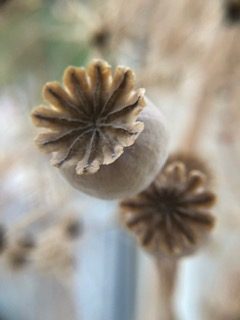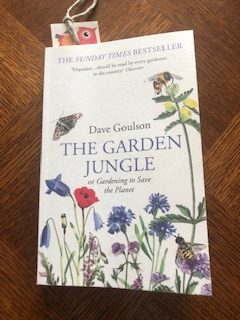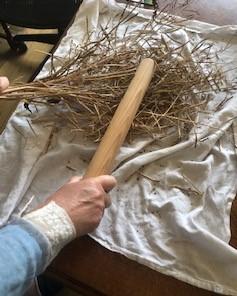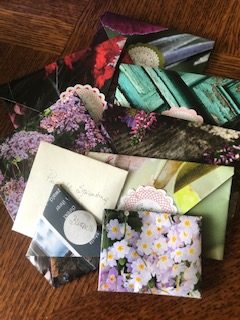I once heard that a true gardener always grows from seed. Not only that, but they will gather their own or swap with friends. Despite the fact that I am not an expert gardener, I am intrigued by this approach. And once I’m intrigued, I feel compelled to try. So this last month, I’ve been carefully collecting all the seed heads from the vegetable patch and flower beds that I would like to sow again next year. Since I’m a novice, I’m starting with the easy ones, but I suspect this might prove a little addictive.

It has taken me the time to collect them (minutes) plus about half a day to prepare them. If my experiment fails, I lose almost nothing; if it works, I gain a great deal in beautiful blooms and crops.
Collecting your own seeds or swapping with friends has a number of advantages: you know exactly what you are planting; that it will thrive in the local soil and of course, it’s free.
Wildlife friendly gardening
My husband and I are currently reading an excellent book called The Garden Jungle or Gardening to Save the Planet that was recommended by a nature loving friend. And if I was starting to waver in my resolve to gather my own seeds, this book put me right back on track.

Image: Karen Costello-McFeat
Suffice to say that growing from seed beats every other option if you are trying to live a greener life. First, it is absolutely efficient in terms of energy costs. You buy a tiny packet of seeds and it is sent to your door, or you gather your own. Second, you do not inadvertently add pesticides to your garden. Those blemish free plants at the garden centre look that way for the same reason that apples in the supermarket are unnaturally perfect. They have been doused many times with a cocktail of chemicals, which are lethal to bees and a myriad of insects.
We garden pesticide free and yes have loads of little beasties. But the great news is that they all sort each other out. Pesticides, on the other hand, tend to wipe out the good and the ‘bad’ insects – with the annoying ones having a tendency to recover more quickly. So you have to spray again and again.
Do I lose plants to slugs and other pests? Of course I do, but I hardly need my flowers or even my vegetable bed to survive and I am happy to share this little patch of earth with my tiny neighbours.
Learning through trial and error
Perhaps there is a YouTube video or guide to all of this, but if there is, I forgot to consult it. Instead, I happily muddled along and worked out a few kinks on the ways. Some plants are ridiculously easy. My wild poppies, once dried*, were eager to spill their bountiful seeds with only a shake of their little heads. Others, like my purple sprouting broccoli, were more coy and required a bit more brute force. I began, initially, carefully prying the pods open over a large cloth. It was very Zen, but likely to take me an eternity. My husband politely pointed out that the old fashioned way was threshing, but how was I to do that? I didn’t have a threshing machine. But I did have a rolling pin and that worked just fine.

Using a large tea towel to gather the seeds was ideal and then I folded up the corners and tipped them onto a folded piece of A4 ready to be poured into their envelopes.
Packaging
As a compulsive envelope maker, I was delighted to find a use for all my origami projects. This was most satisfactory. I could sort my seeds, place them in pretty containers and label them so that I would be able to easily identify what was what. (Our of their pods and seed heads, they all look disconcertingly similar.)
This was the fun part. Using the folded paper, I tipped what I thought was a useable amount into an envelope. I then added a label and voila! Seeds for next year. Some I will use for sprouts and if they succeed, I’m sure the ones I plant will too.

Share
As you can see, I have plenty to use and plenty to share. If all goes well; next year, I will try to gather even more. And as summer comes to an end, I encourage you to collect some seeds of your own. Placing the ones I’d garnered into their pretty packaging took away some of the sadness one feels at the passing of the season and sowed instead a little hope.
*When drying plants for any purposes, you want to hang or stack them (like a little sheaf of corn) to allow the maximum circulation of air and store in a warm, dry place. Only when they are absolutely dry should you attempt to remove the seeds within.

Funny, I just planted some seeds the other day! A friend sent me some of her Sweet pea seeds and I had some veggie seedlings for Christmas. They are now all cozy in a blanket of fine seed and cutting compost and protected in little incubators before I put them out in the warmer Spring weather. We are just about there here in Melbourne. It is going to be a warm 20 degrees today and due to our continued lockdowns (204 days total and counting) , gardening is one thing that’s allowed! I will endeavour to harvest this year too … x
You have very pampered seedlings and I’m sure they will reward you with a healthy crop! I hope that your lock-down will come to an end soon. Till then, I’m glad you are making the most of your time. With spring on the way, things can only get better! xx